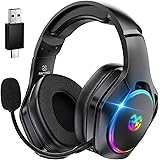The quest for superior gaming audio often leads enthusiasts down a rabbit hole of marketing hype and flashy RGB. With a market saturated by “gaming” branded peripherals, studies indicate that a significant portion of consumers are swayed by aesthetics and buzzwords rather than genuine acoustic performance. As highlighted in the accompanying video from RTINGS.com, the traditional gaming headset paradigm, while convenient, doesn’t always deliver the fidelity and precision discerning gamers crave. This article expands on that discussion, delving deeper into why a pivot towards audiophile-grade headphones and in-ear monitors (IEMs) could dramatically elevate your gaming experience, detailing critical considerations and specific recommendations for finding the best audiophile gaming headsets.
Beyond the Buzz: Why Audiophile Headphones for Gaming?
Gaming today is more immersive and competitive than ever, demanding audio clarity that goes beyond mere explosions and voice chat. True audiophile headphones offer a fundamental advantage: superior sound reproduction. These devices are engineered for accuracy and detail, allowing gamers to perceive subtle audio cues—like distant footsteps or directional gunshots—with unparalleled precision.
1. **A Question of Features vs. Fidelity:** Many purpose-built gaming headsets prioritize features such as wireless connectivity, integrated apps, and extensive RGB lighting. While these add convenience, they often come at the expense of raw sound quality. Audiophile options, conversely, strip away the superfluous to focus purely on acoustic excellence, often providing a more impactful experience for open-back headphones for gaming.
2. **Compatibility and Setup Nuances:** The primary consideration with audiophile headphones is their compatibility, particularly with consoles. Wired connections offer near-universal compatibility across PCs and consoles, but managing cables is a trade-off. For console gamers, connecting an amp/DAC or splitting audio from an HDMI signal might be necessary to properly drive higher impedance headphones. Many console controllers, despite offering a 3.5mm jack, may struggle to power demanding audiophile headphones to adequate volumes.
3. **Microphone Integration for Social Gaming:** Modern gaming is inherently social, requiring clear communication for competitive callouts or casual squad interaction. Most audiophile headphones lack a built-in microphone. However, the aftermarket offers a wealth of solutions, from attachable boom mics like ModMics to integrated cables with microphones. PC users can even opt for high-quality standalone recording microphones, ensuring crystal-clear comms.
Optimizing Your Gaming Audio: Convenience and Versatility
While audiophile gear might seem less convenient initially, strategic choices can maximize flexibility. Software-based equalization on PC, or specific features on some Bluetooth gaming headsets, can tailor sound profiles to individual games or preferences.
1. **Sound Customization with Equalization:** Many wireless gaming headsets allow for sound customization via graphic EQs and presets through companion apps. This is particularly useful for console gamers, though not all headsets retain these adjustments across devices. PC gamers have access to powerful, free software like Equalizer APO, enabling precise sound tweaking for any headphone.
2. **Versatility Beyond Gaming:** Audiophile headphones excel in versatility. While gaming headsets can double as casual listening gear, audiophile headphones are specifically designed for critical listening, allowing you to discern minute details in music. For those seeking a device that performs equally well in gaming and music enjoyment, this versatility is a significant draw, especially for the best wired gaming headphones.
Demystifying Audio Metrics: What Truly Matters for Gaming
Understanding key audio metrics is crucial when evaluating audiophile headphones for gaming. These metrics provide objective insights into how a headphone will perform in scenarios where spatial audio cues are vital.
1. **Imaging and Stereo Matching:** Imaging refers to a headphone’s ability to accurately place sounds within the stereo field. Excellent imaging allows you to pinpoint the direction and distance of in-game events like footsteps or gunshots. Stereo matching, a quantifiable metric, ensures both drivers (left and right) reproduce sound identically, which is critical for accurate spatial awareness. Slight mismatches, especially in higher frequencies, can subtly shift the perceived location of sounds, impacting competitive performance. RTINGS.com, having tested over 830 headphones, consistently emphasizes these metrics as foundational for gaming prowess.
2. **Group Delay and Harmonic Distortion:** Group delay measures how consistently a headphone reproduces different frequencies over time. Low group delay ensures that all parts of a sound arrive at your ear simultaneously, maintaining sonic coherence. Harmonic distortion refers to unwanted frequencies added to the original sound signal. Minimizing this ensures clarity and fidelity, preventing muddy or distorted audio, which is crucial when searching for the best closed-back gaming headphones for immersive experiences.
Exceptional Audiophile Recommendations for Gamers
Moving from theory to practical application, here are audiophile-grade options that consistently impress in gaming scenarios, catering to various budgets and preferences.
Budget-Friendly Open-Back Headphones (Under $100-150)
Open-back designs are frequently praised for their expansive soundstage, offering a perception of space and directionality. While subjective, many gamers find this beneficial for immersion and competitive awareness.
1. **Superlux HD 681:** Often available for sub-$50, the Superlux HD 681 offers solid imaging performance, accurately rendering spatial cues. Its bright frequency response can be divisive—some find it detailed, others harsh. While comfort is decent, durability shows concessions at this price point. A slightly more robust option, the Superlux HD 681 EVO, exists, though the acoustic improvements might not justify the additional cost for all users.
2. **Philips SHP9500 / SHP9600:** Priced higher than the Superlux, these Philips models boast a sturdier build with metal components and a padded headband for enhanced comfort. Both are open-back and provide solid imaging. The SHP9500 is often preferred due to the SHP9600’s bass emphasis and downward-tilting mids, which can muddy dialogue. An elevated phase response mismatch past 10 kHz is noted, but generally less audible to most.
In-Ear Monitors (IEMs) for Competitive Edge
While lacking the expansive soundstage of open-back headphones, IEMs compensate with superior passive noise isolation and potent bass reproduction. Their compact nature and often robust bass make them surprisingly viable for competitive play, even among top-tier esports professionals.
1. **Truthear x Crinacle Zero (Blue & Red):** Both variants offer comfort, build quality, and excellent stability. They perform well in imaging metrics like stereo mismatch and group delay, aiding spatial cue detection. The Blue has a V-shaped sound with a sub-bass taper, while the Red provides a more balanced profile. The Red also includes a 10-ohm adapter to add low-end thump while maintaining its high-bass taper, offering robust bass for impactful in-game explosions.
2. **Truthear Hexa:** From the same brand, the Hexa provides a more balanced sound signature than the Crinacle collabs. While some might find it less “fun” than V-shaped alternatives, its balanced tuning is highly effective for both casual listening and precise gaming. It excels in stereo matching tests, proving a worthwhile upgrade for those prioritizing accuracy.
Mid-Range Over-Ear Options (Above $150-200)
This price segment opens up a broader selection of high-performance audiophile headphones that cater to demanding gamers, offering a balance of technical prowess and comfort.
1. **Beyerdynamic DT 990 PRO (80-ohm variant):** A well-respected name in gaming, the DT 990 PRO delivers solid stereo driver matching, clean group delay, and outstanding harmonic distortion. This makes footsteps in games like Escape from Tarkov exceptionally clear. Its sound signature features a welcome high-bass boost but also a characteristic bright treble with a peak around 9 kHz that some find fatiguing. The 80-ohm version is typically loud enough for most users, even with console controllers. The newer DT 990 PRO X (48-ohm) reportedly tames the treble.
2. **Sennheiser HD 560S (120-ohm):** These open-back headphones offer a flat sound profile, making them arguably more suited for precision than immersion. They accurately represent positional cues in competitive shooters. While our unit showed some imaging issues due to driver mismatch, this can vary by unit due to quality control. Powering these 120-ohm headphones on consoles usually requires an external amp or DAC.
3. **Sennheiser HD 490 PRO:** Prioritizing comfort, the HD 490 PRO ranks among the most comfortable headphones tested, especially with its “producing” earpads. Acoustically, they excel with strong imaging performance in stereo matching and group delay, allowing precise enemy location. Their solid bass extension and pronounced high-bass make them excellent for cinematic games, adding depth to explosions and soundscapes. These are truly excellent audiophile gaming headsets.









